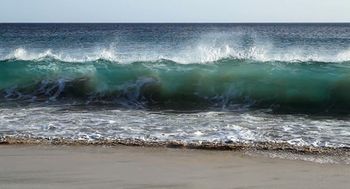Plunging wave in slow motion
This article points to the videos of a plunging wave event in slow motion, exhibiting all the stages of the wave breaking onto a sandy beach on a windless day.
The onset and development of breakers in the shoreface impresses because of their rapidity, dynamic range, and dramatic mixture of chaotic and cyclic behaviours. This recording shows remarkably clearly a shoaling wave that steepens suddenly, grows into a sequence of narrowly spaced plunging breakers, and dissolves explosively into spray and foam on a natural beach. Upon close inspection, also clearly visible are the sand entrained within the curling wave and that stirred and suspended in the foreshore.
The individual frames of the videos are commented and distributed under a licence CC BY-SA (attribution and share-alike) at Zenodo[1]. The videos are derivative work of an amateur recording published in the Wikipedia Commons[2].
Location description
The video was taken on 11 February 2013 at the sandy beach Playa del Matorral, in the locality Morro Jable, municipality of Pájara, in the island of Fuerteventura, Canary Islands, Spain. The Playa del Matorral faces SSW and SE and thus, roughly speaking, the African coast. The region is tidal: the water-level excursion at the nearby Puerto del Rosario is reported to be 2.3 m at springs and 1.6 m at neaps. The seabed declines fairly steeply, approximately down to -500 m within 2 km or less from the mean sea level line.
The development of a plunging breaker is clear evidence that the beach is behaving as a reflective one. If present at all, nearshore sandbars do not appear to affect the breaking process. Indeed, the closeness to the shore of the breaking line, the narrow shoreface, and the collision of backwash and incoming waves are indicators of a steep shoreface profile. In a steady beach configuration, these plunging waves must bring ashore sufficient sediment to compensate for the offshore transport down the steep slope.
Breaker description
The videos, slowed down up to eightfold the physical speed, unveil the scales of motion interleaved within the mixture of water, sand and air in such a sudden and rapid event. Despite some processes are occluded out of the view, the recordings uncover the following stages of development and features:
- The waves shoal with long arrival times. A single episode of breaking seems to occur as in an isolated solitary wave, except for the backrush of the previous event reinforcing the steepening of the following. Extrapolating the evidence from the recording, a small-amplitude swell or edge wave with a period of 13-16 seconds could cause the event on record;
- The recording is taken on a windless day and no extensive surf zone influences the nearshore zone seaward of the plunge point;
- The sand moving and floating in the water's edge is visible both in the waves and in the water that rises as the breaking wave steepens and curls (see picture above);
- The backrush from the previously broken wave has largely returned seawards when a fresh plunger engulfs the foreshore; this illustrates the cycling behaviour expected in a wave also as regards the sand motion;
- The breaking does not unfold as a single wave form that seamlessly steepens, curls, and collapses after a single point of instability has been touched. Instead, the first wave face spawns new crests of water while advancing over the small plunge distance. Each crest surges ahead and leaves behind the previous one, which nonetheless impinges on the back of the leading wave face and breaks behind it. The breaking of this seeming single breaker is, in fact, remarkably composite and nonlinear;
- Because of the considerable steepening, the plunging wave engulfs a considerable volume of air that produces the impressive explosion of spray in turn.
This evidence on a natural beach can usefully be contrasted with the laboratory studies of Sumer et al (2013[3]), who compare the breaking of a train of plunging waves in a flume with and without a sand bed; and of Hafsteinsson et al (2017[4]), who report systematic observations of spilling, plunging and surging breakers in a narrow channel with a uniform bed slope.
Related articles
References
- ↑ Lipari, 2023. The sequence of motions of water and sediment in a single plunging breaker on a sandy beach. Zenodo. https://doi.org/10.5281/zenodo.7601924
- ↑ Vincentz, 2013. Pájara - Morro Jable - Playa del Matorral https://commons.wikimedia.org/wiki/File:P%C3%A1jara_-_Morro_Jable_-_Playa_del_Matorral_(0)_09.ogv
- ↑ Sumer, B.M., H.A.A. Guner, N.M. Hansen, D.R. Furham, and J. Fredsøe. 2013. Laboratory observations of flow and sediment transport induced by plunging regular waves. Journal of Geophysical Research: Oceans, 118:6161-6182, DOI:10.1002/2013JC009324
- ↑ Hafsteinsson, H.J., Evers, F.M., and Hager, W.H. 2017. Solitary wave run-up: wave breaking and bore propagation. J. Hydr. Res. 55: 787-798 DOI: 10.1080/00221686.2017.1356756
Please note that others may also have edited the contents of this article.
|
